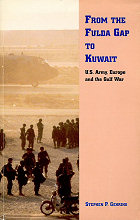
GEHRING : From the Fulda Gap to Kuwait (előszó)
Iraq's aggression against the oil-rich emirate of Kuwait in August 1990 sparked an international crisis in a part of the world vital to the West but where the United States and its allies maintained few land-based forces. As a result, the United States faced a significant test of its ability to project decisive military power to the Persian Gulf region in a timely and effective manner and to employ those forces as the cutting edge of the international coalition.
The United States Army contributed the bulk of the manpower and much of the equipment that this nation dedicated to the coalition's triumph. While airborne soldiers based in the United States were the first ground troops to deploy to Saudi Arabia in response to the crisis, U.S. Army, Europe (USAREUR), ultimately sent a heavy armored corps and thousands of support troops and equipment that provided the critical mass to the coalition, contributing immeasurably to the historic 100-hour land victory over Iraq. In this book we will examine the efforts made by USAREUR to deploy the substantial land forces that proved so critical to the success of coalition operations in the Persian Gulf.
At the time of the crisis in the Gulf, U.S. forces had been stationed in Western Europe for over forty years, protecting American vital interests from the powerful armies of the Soviet Union and its Warsaw Pact allies. In 1989 and 1990, however, the threat environment in Europe underwent a profound change. Cold War tensions diminished substantially as a result of the cutbacks in military forces undertaken by Mikhail Gorbachev and his government's acquiescence to the collapse of Communist regimes across Eastern Europe. These sea changes in the threat enabled a substantial portion of the American forces based in Europe to expand their focus to events in the Gulf.
Prior to the Gulf crisis, the U.S. government's reaction to the political changes in Eastern Europe was marked by a prompt but careful reevaluation of America's international responsibilities and associated military requirements. At the direction of Headquarters, Department of the Army leaders of U.S. Army, Europe, drew up plans for a smaller but more versatile force on the Continent—a force that could rapidly respond to crises throughout the region. As early as 1989, USAREUR began to introduce significant alterations in unit equipment, and it broadened its training focus appropriate to an expanded range of mission requirements. USAREUR also planned to begin substantial reductions in its aggregate force levels beginning in late 1990. Through this period, NATO headquarters, the Department of Defense, and the joint commanders in Europe were actively involved in the planning process.
When the war in the Gulf erupted, USAREUR's reduction plans were temporarily put on hold. But the expansion in the focus of USAREUR training had resulted in Army forces well prepared for military action and mobile warfare in a theater as remote as Kuwait. The training revolution begun in the Army in the early 1980s had come to full fruition by the end of the decade—Army war-fighting doctrine in USAREUR was understood and practiced; training was executed to an exacting standard. USAREUR units, as part of the finest Army our nation has ever fielded, were trained and ready.
By the autumn of 1990, USAREUR had obtained the world's most modern equipment for armored land warfare, ranging from superior tanks, armored personnel carriers, and artillery vehicles to sophisticated attack helicopters and exceptionally rugged and reliable tactical wheeled vehicles. USAREUR troops were among the very best our nation had to offer. They spent five months of each year in a field training environment, mastering the tactics, techniques, and procedures that would undergird victory in battle. It was to these well-prepared and well-led troops in Europe that the Pentagon turned to provide the heavy armored corps that would anchor the American land attack in the Gulf and defeat Iraq's most formidable military formations.
This book describes how U.S. Army, Europe, assembled, prepared, and deployed the powerful forces it contributed to the coalition effort in the Gulf and how USAREUR accomplished these challenging missions while maintaining its continuing security responsibilities on the Continent and preparing to execute its program of force reductions. The book discusses the complicated planning for the deployment and the rapid-fire implementation of those plans, the troops sent to the Gulf and the equipment they employed, and the contributions of the nondeploying troops to the support of family members left at home in Europe. This study also examines how, in the aftermath of our victory in the Gulf, USAREUR redeployed its forces and immediately returned to the tasks of reorganization and reduction developed before the war.
The versatility deployability and lethality that USAREUR forces demonstrated in the Gulf War provide an eloquent and powerful statement on the value derived by this nation from a trained and ready Army. As we look ahead to a new era of challenge and change, the historic accomplishments of USAREUR represent a model for those now charged with shaping the Army for the next century—an Army that must retain its ability to protect and advance vital American interests any place, any time.